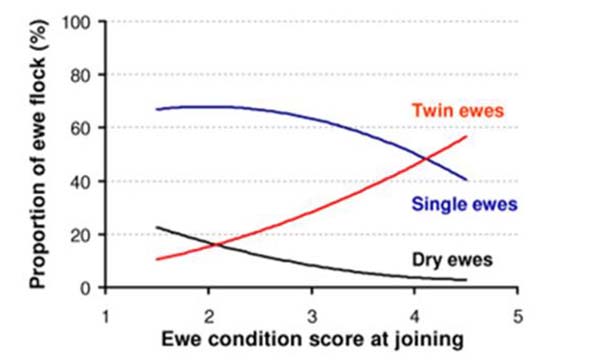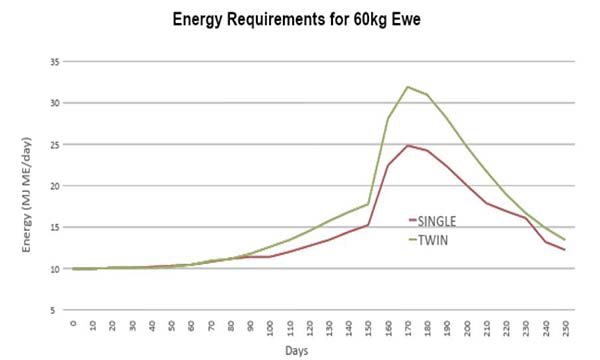Joining in containment allows producers to improve body condition score of ewes. Elders Livestock Production Specialist Steph Warwick, based at Elders Strathalbyn explains how.

There are two factors at play:
Firstly, reproductive ability is related to condition score (CS). As the graph below demonstrates, the proportion of twins, singles and empties is a product of CS at joining.
 Graph showing correlation between a ewe's condition score and pregnancy. Source: www.livetimewool.com.au
Graph showing correlation between a ewe's condition score and pregnancy. Source: www.livetimewool.com.au
Secondly, the strength of oestrus is determined by the energy balance prior to joining – often referred to as a rising plane of nutrition. Flushing ewes by increasing energy and protein intake prior to joining will improve conception.
Increasing metabolisable energy (ME) intake two weeks prior to joining (coincides with the introduction of teasers) by at least 25 per cent will also promote a stronger oestrus.
Experience has demonstrated that better conception rates (fewer empty ewes) and better weaning rates (lambs weaned to ewes joined) are achieved by managing nutrition prior to joining and throughout early and mid-pregnancy.
Energy requirements for ewes (and cows for that matter) are reasonably stable for the first 80 days of pregnancy. For all intents and purposes, ewes can be fed at maintenance till day 80 or 90, which usually coincides with pregnancy scanning.
Best practice is to assume all ewes are carrying twins, up to the point of scanning. Once twins and singles have been identified, differential feeding can commence – allocate more, or less as required.
Apart from the obvious advantage of preserving ground cover, there is a significant saving in feed. Sheep in containment require less energy, as grazing sheep and cattle use valuable energy moving.
In some cases, you could save approximately 8 cent per head per day advantage. While this may not seem like much, for a regular mob of ewes over 140 days, you would save thousands.
Post scanning, and up to the point of lambing, feed can be allocated according to pregnancy status.
 Graph showing the energy requirements of a 60kg ewe.
Graph showing the energy requirements of a 60kg ewe.
If stock have been contained early enough, and sufficient residual fed has been saved, they can then be depastured a week prior to lambing and (hopefully) left alone for at least the first cycle of lambing. Supplementary paddock feeding can be resumed, if necessary, once 80 per cent (first cycle) of ewes have lambed.
Another significant advantage of containment feeding is more accurate monitoring of condition. It takes twice as much energy (and complimentary protein) to put on condition than it does to maintain it. Allowing ewes to lose condition during pregnancy is not only detrimental to lamb survival but also very costly, as the table below demonstrates.
| 60kg dry ewe, CS 3 | Maintain condition | Lose condition |
|---|---|---|
| February/March | ||
| ME Supplement (Grain mix = barley + buffer) | 10 MJ (0.9kg/h/d) | 6 MJ(0.5kg/hd/d) |
| Energy Balance | Maintain | Lose 0.6 CS /month |
| April/May | ||
| April/May feed (max gain 0.5 CS/month) | 11 MJ (1.0kg/h/d) | 16 MJ (1.5kg/h/d) |
| Condition Score end May | 3.0 | 2.8 |
| Total Feed | ||
| Ration cost = ($400/t) | 36c/day for 60 days 40c/day for 60 days | 25c/day for 60 days 60c/day for 60 days |
| Total cost 4 months | $45.00 | $54.00 |
Please note: this article contains information of a general nature, and does not take into account your personal objectives, situation or needs. Before acting on any information, you should consider the appropriateness of the information provided, and seek advice on whether it is fit for your circumstances.
